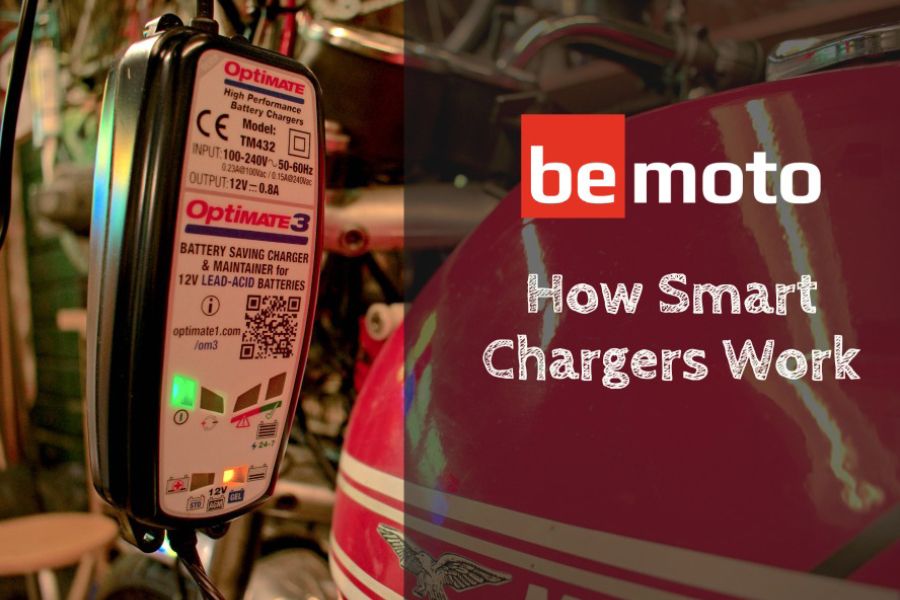Battery Smart Chargers: How They Work
By BeMoto

Don’t be left flat this winter, here’s our guide to keeping your battery healthy
Old and cold - not a great combination for a motorcycle battery! For riders who don’t use their bikes regularly - particularly over for winter - or for long rides, there’s a strong chance the battery will go flat if not maintained. It isn't just old batteries that are vulnerable to this, even a reasonably fresh battery can soon run down.
To avoid the expense of replacing your battery or worse - not being able to go for a ride when you want to - we recommend you invest into a smart charger to keep it powered up. For a list of recommended smart chargers, take a look at this page. But as nobody in the BeMoto office could explain how they actually work, we spoke to the professionals at OptiMate the battery saving experts, to ask them exactly that along with every other question we could think of on this topic.
To see our Top Five motorcycle smart chargers, take a look here
Is a smart charger the same as a trickle charger?
No, definitely not. A trickle charger drip feeds current into a battery until it is fully charged, then stops. If you leave your bike for long periods between rides, weeks or months, the battery will lose charge through natural wastage and you would need to check it regularly with a voltmeter and reconnect the trickle charger every time it needed topping up.
Smart chargers, pioneered by OptiMate in the 1990s, constantly monitor the battery, topping it up when necessary, so it’s always fully charged. This is much more convenient, because you can leave them connected when the bike is parked up for a long while and the battery will always be brim full.
In fact the OptiMate24/7 programme automatically maintains the batterty every hour, always monitoring and then replacing only the charge drained in that previous hour. The longer you leave the battery connected, the stronger it becomes!
How does a smart charger restore a battery?
The chemicals in a battery lose their potency over time, in much the same way that an unopened bottle of cola will eventually go flat. When a battery becomes deeply discharged, the chemicals inside break down and lead sulphate crystals form around the plates, which stops them producing a current. This is why some batteries either refuse to recharge or go flat almost immediately after recharging. Specialist chargers, like the OptiMate 3, can desulphate a battery, using high charge pulses to break down the crystals and then gently coax the battery back to life. To protect your bike and its on-board electronics, this programme will only start when the charger senses no other electronics on the battery. So if your battery is too weak to start your bike’s engine, disconnect the battery and your smart Optimate charger will safely desulphate your battery back to life.
Will a smart charger damage a battery if left on too long?
No, a good quality smart charger from a reputable specialist manufacturer, like OptiMate, will be 100% safe.
The longer you leave the battery connected, the stronger it becomes! Additionally, OptiMate include several safety features, such as built-in protection from spark, overcharge and short-circuit to ensure they are completely safe to leave connected for long periods.
How much electricity does a smart charger use per day?
Pennies. Since they only operate at full power when the battery needs topping up, they use very little electricity.
Is it better to remove a battery from a bike when using a smart charger in order not to harm the motorcycle?
Smart chargers are designed to be connected to the battery 24/7 so there is no need to disconnect the battery. The current is not strong enough to damage the electronics on a motorcycle - this is only a danger when jump-starting from a car or van.
Do I need a special charger for lithium batteries?
Yes. Absolutely. Unless you choose an OptiMate Duo charger, which automatically detects whether a battery is lead-acid or Lithium-ion LFP and charges accordingly. Using a traditional charger can easily overheat a lithium battery, causing it to fail, catch fire or, in extreme circumstances, explode!
How do lithium and ‘conventional’ batteries differ in terms of their charging and maintenance?
Without getting too technical, Lithium-ion LFP batteries pack a bigger punch than regular AGM lead acid items, so you can use a smaller, lighter battery to start your bike. The downside is that they are lower capacity, so they discharge sooner when fitted to a bike. Some also have a battery management system (BMS), which will refuse to accept charge if it believes the battery is too weak. To recharge these batteries, you need a charger that has a BMS-reset function, only found on the specific OptiMate Lithium Chargers.
Regular chargers designed for lead-acid batteries deliver high current at low voltage and then taper off, whereas a lithium battery needs a controlled low current charge until it reaches 12.8V to bring it back to life.
Will a cheaper Optimate/Smart Charger be just as good as the more expensive ones? What’s the difference?
Entry level OptiMate chargers, like the Duo 1 and 2, use exactly the same microprocessor-controlled technology and high end accessories as the top of the range models. As you go up the range, you get more features. For example, the OptiMate 3 can desulphate deeply discharged batteries and the OptiMate 4 can ‘talk’ to BMW motorcycles with CAN bus electronics.
Do all smart chargers - no matter the manufacturer - charge/maintain the battery in the same way?
Yes and no. In theory they all monitor the battery and top up as necessary, but there are some technical differences. For example, OptiMate’s maintenance programme that automatically connects and disconnects every hour is unique.

